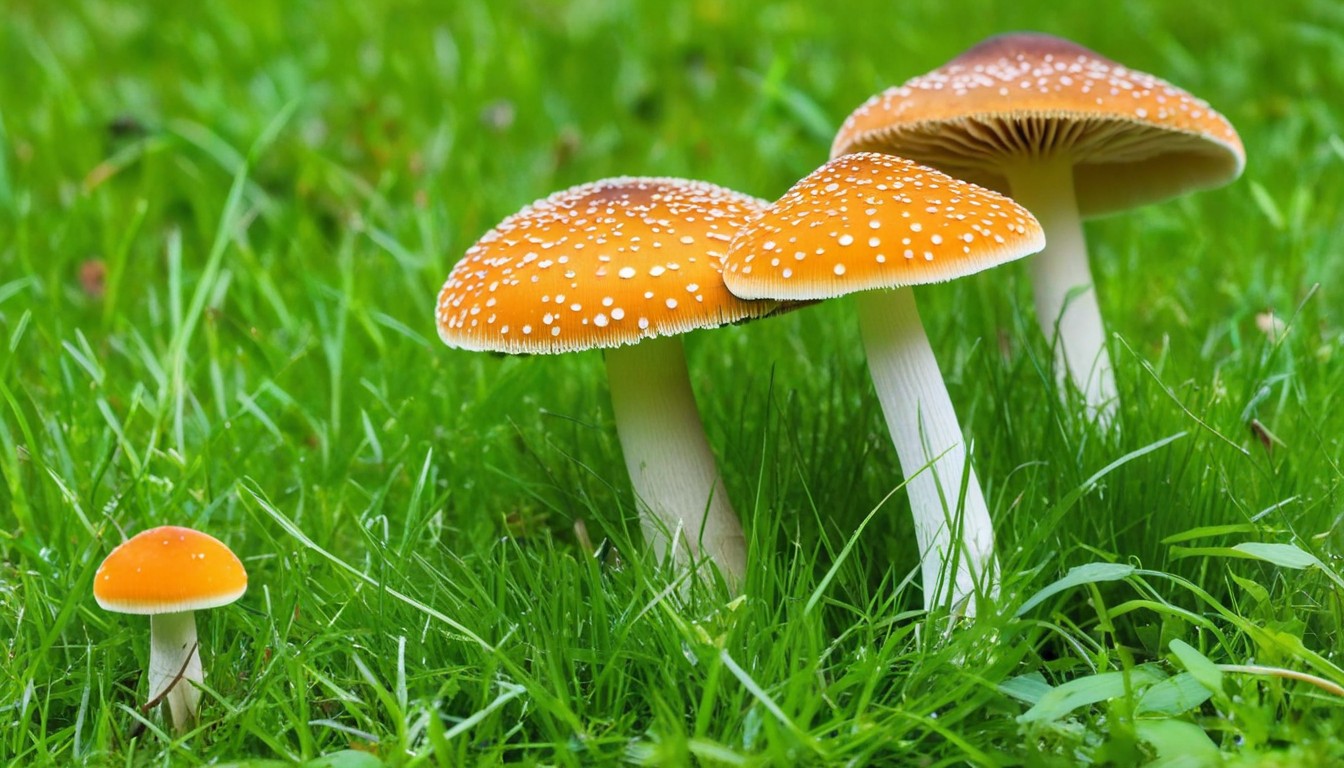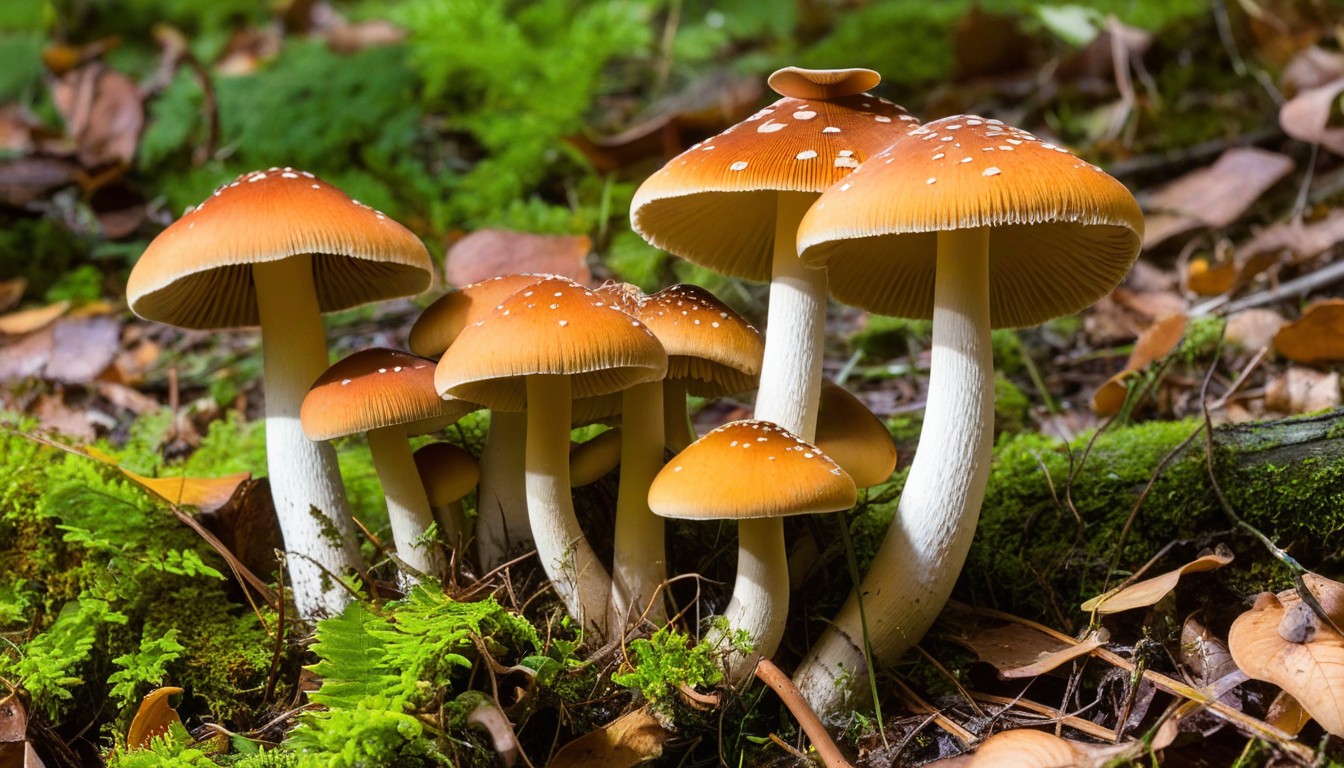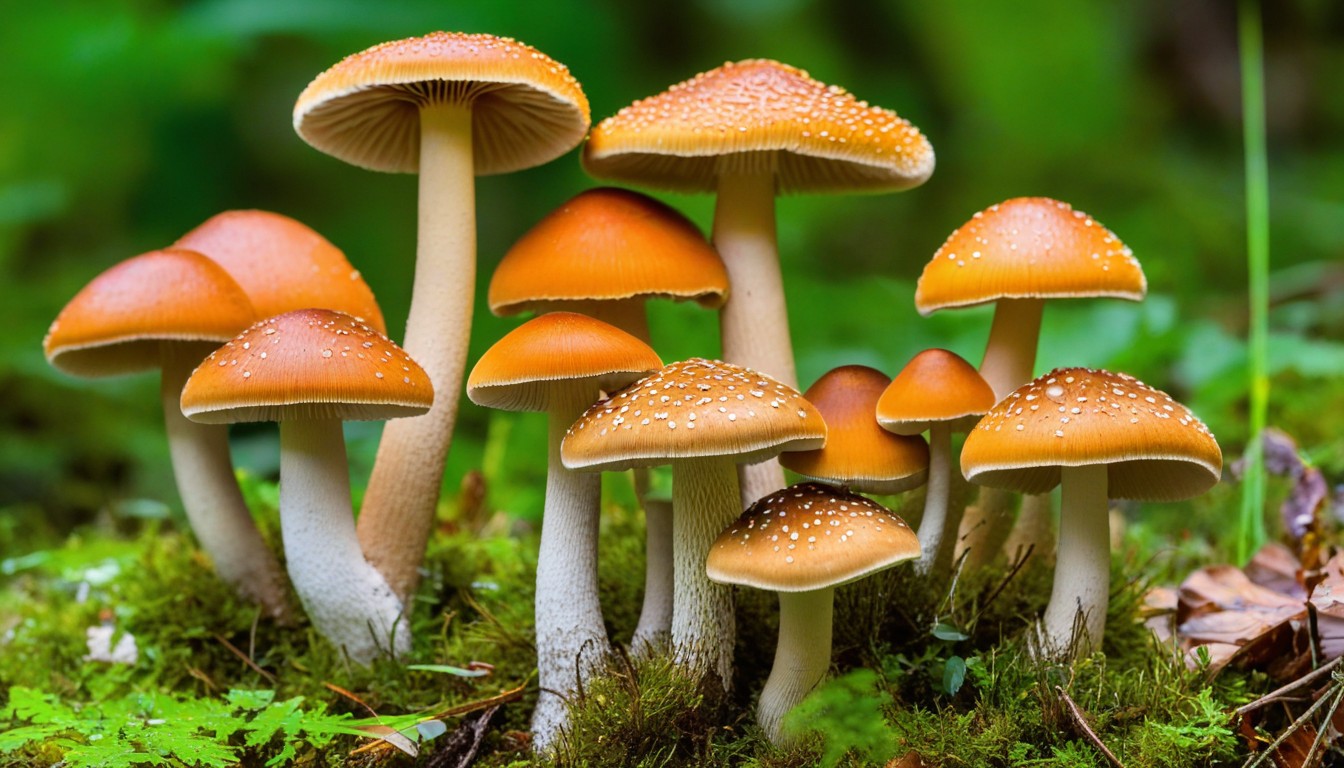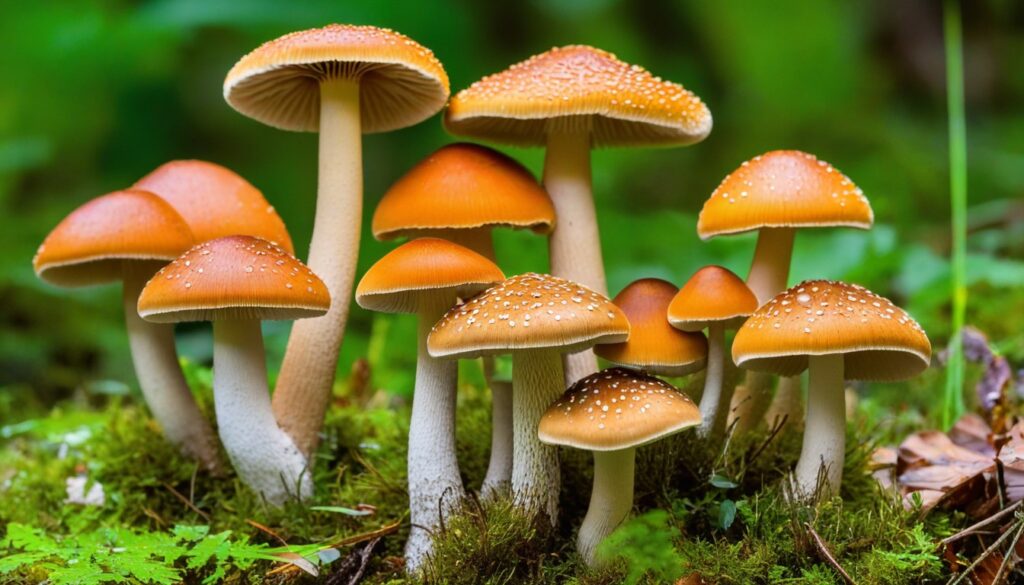Are you a foodie seeking adventure and natural culinary delights? Do you live in Florida or plan to visit soon? Look no further than Florida’s bountiful edible wild mushrooms. In this comprehensive guide, we will delve into the world of Florida’s edible wild mushrooms and equip you with all the information you need to safely forage and enjoy these natural treasures.
Key Takeaways
- Florida is home to a variety of edible wild mushroom species.
- Foraging for wild mushrooms requires proper identification and safety precautions.
- Practicing sustainable foraging techniques is essential for preserving Florida’s ecosystem.
- Florida edible wild mushrooms offer various culinary and potential health benefits.
- Cooking and preserving techniques can enhance the flavors and extend the shelf life of Florida’s edible wild mushrooms.
Why Forage for Edible Mushrooms in Florida?
Florida is home to a diverse ecosystem that creates the perfect environment for foraging for edible mushrooms. The climate in Florida is also favorable for production, making it an excellent spot to find a wide variety of edible mushroom species. Here are some of the unique advantages of foraging for edible mushrooms in Florida:
- Warm Climate: Florida’s warm climate provides the ideal conditions for mushroom production, and many edible species are available to forage all year round.
- Diverse Ecosystem: Florida boasts a diverse ecosystem, featuring different natural habitats like sandy beaches, swamps, and dense forests, all with their unique mushroom species.
- Abundance of Species: With over 4,000 species of mushrooms in Florida, you are sure to find an ample supply of delicious, edible ones to forage.
So if you are a mushroom enthusiast or just looking for an exciting new hobby, head to Florida to immerse yourself in the world of edible wild mushrooms!
Safety Precautions for Mushroom Foraging
Foraging for wild mushrooms can be a thrilling and rewarding experience, but it’s essential to take the necessary precautions to ensure your safety. Here are some guidelines to follow before, during, and after your mushroom hunting trip:
1. Educate Yourself
Before setting out on your mushroom foraging adventure, make sure you are familiar with the different mushroom species found in your area. Research their distinctive features, habitat preferences, and look-alikes to ensure you can safely distinguish the edible mushrooms from the toxic ones.
2. Bring a Field Guide and a Mushrooming Knife
A good field guide is an indispensable tool for any mushroom hunter. It can help you identify different species and provide valuable information about their edibility. Additionally, a mushrooming knife with a sharp blade and a brush can help you safely and efficiently collect the mushrooms while avoiding damage to their habitats.
3. Wear Proper Gear
When foraging for wild mushrooms, make sure you dress appropriately. Wear comfortable clothing and sturdy shoes that can endure the challenging terrains. Additionally, bring a hat, sunscreen and insect repellent, especially if you’re foraging in the woods during warm weather.
4. Practice Responsible Foraging
Always take care to forage in a responsible and ethical manner. Don’t damage the habitats or disturb wildlife, and only collect what you can responsibly consume or share with others. Furthermore, avoid foraging in protected areas, such as national parks, where it may be prohibited.
5. Bring a Buddy
Foraging with a companion is safer and more enjoyable than foraging alone. Bring a friend or family member along, especially if you’re a beginner, to share the memorable experience of discovering new and delicious wild mushrooms.
By following these safety precautions and guidelines, you can have a positive and enjoyable mushroom foraging experience while minimizing the risks associated with wild mushroom consumption.
Identifying Edible Mushrooms in Florida
With over 2,000 species of mushrooms growing in Florida, it can be a challenge to identify which ones are safe to eat and which are poisonous. Here are some tips to help you identify edible mushrooms found in Florida.
Distinctive Features
Edible mushrooms in Florida can vary greatly in appearance. However, there are some common features that can help you identify them. Edible mushrooms generally have fleshy caps and stems, and the cap may be smooth or have a rough texture. Colors range from white to brown to red, but avoid mushrooms with bright colors, as these are often poisonous. Additionally, edible mushrooms typically have a pleasant, earthy smell.
Habitat Preferences
Different species of edible mushrooms in Florida have different preferences for where they grow. Some mushrooms thrive in shaded or damp areas, while others prefer sunny, open spaces. Additionally, mushrooms tend to grow in specific types of soil, such as sandy or clay-based soil. Knowing the habitat preferences of different mushrooms can help you narrow down your search.
Common Look-Alikes
Many poisonous mushrooms in Florida bear a striking resemblance to edible ones. It’s important to be able to recognize the differences to avoid potentially harmful mistakes. For example, the deadly galerina mushroom looks similar to the edible honey mushroom. However, the galerina has a ring on the stem, while the honey mushroom does not. Other common look-alikes include the poisonous death cap mushroom and the edible straw mushroom.
|
Mushroom |
Distinctive Features |
Look-Alikes (Poisonous) |
|---|---|---|
|
Chicken of the Woods |
Bright yellow/orange color; shelf-like growth habit |
Jack-O-Lantern Mushroom |
|
Morel |
Conical cap with pits and ridges; hollow stem |
False Morel |
|
Chanterelle |
Smooth, vase-shaped cap; wavy, forked gills |
Jack-O-Lantern Mushroom |
Remember, when in doubt, do not eat the mushroom. It’s better to be safe than sorry.
Best Places to Forage for Edible Mushrooms in Florida

If you’re looking for the best places to forage for edible mushrooms in Florida, you have plenty of options. Here are some of the top locations to consider:
|
Name |
Location |
Best Time to Forage |
Popular Mushroom Species |
|---|---|---|---|
|
Alafia River State Park |
Lithia, Florida |
Spring, Fall |
Chanterelles, Morels, Chicken of the Woods |
|
Ocala National Forest |
North Central Florida |
Spring, Summer, Fall |
Oyster Mushrooms, Lions Mane, Honey Mushrooms |
|
Paynes Prairie Preserve State Park |
Micanopy, Florida |
Fall |
Giant Puffballs, Chanterelles, Hen of the Woods |
|
Myakka River State Park |
Sarasota, Florida |
Fall, Winter |
Oyster Mushrooms, Chanterelles, Lion’s Mane |
Each location offers unique accessibility and mushroom species, so it’s essential to research and plan before heading out to forage.
If none of these locations are nearby, don’t worry! With the diverse ecosystem and abundance of edible mushroom species in Florida, there are many other places to explore. Just make sure to always obtain proper permission and follow safety guidelines before venturing out.
Seasonality of Florida Edible Mushrooms
Understanding the seasonality of Florida’s edible wild mushrooms is essential for successful foraging. The state’s warm and humid climate allows for year-round mushroom growth, but certain species are more prevalent during specific seasons.
Fall
In the fall, look for chanterelles, hen of the woods, and shiitake mushrooms, which can be found growing on dead logs and stumps. This is also the season for black trumpets, which are small and funnel-shaped, with a smoky, earthy flavor.
Winter
Winter is the prime season for the highly coveted black and white truffles, which grow underground and are often hunted with the help of trained dogs. Other popular species during this season include morels and oyster mushrooms.
Spring
During the spring, you can find coral mushrooms, which have a coral-like appearance and a fruity, delicate flavor. Morels are also prevalent during this season, along with the bright red and white fly agaric.
Summer
The summer season yields a variety of mushrooms, including chicken of the woods, which has a meaty texture and lemony flavor, and the classic button mushroom, which can be found growing in lawns and meadows. Look out for the bright orange chanterelles, as they start to appear more frequently towards the end of the summer.
The seasonality of Florida edible mushrooms allows for year-round foraging opportunities, provided that you know where and what to look for. In the next section, we’ll explore some of the best places to forage for these natural treasures in Florida.
Necessary Tools and Equipment for Mushroom Foraging

For a successful mushroom foraging trip in Florida, you’ll need to come with some necessary tools and equipment. Here are some of our recommendations:
|
Tools/equipment |
Usage |
|---|---|
|
Basket or mesh bags |
For carrying and storing mushrooms; wire baskets are preferable since they allow spores to escape and spread. |
|
Knife |
To cleanly cut the stem of the mushroom from the ground, particularly for species like Chanterelles which bruise easily. |
|
Field guide |
For identifying different species of mushrooms and ensuring you’re not mistaking poisonous mushrooms for edible ones. Florida features a range of species – Cinnabar Chanterelle, Black Chanterelle, Lion’s Mane, and Chestnut mushroom, to name a few. |
|
Flashlight/headlamp |
To help with the visibility and accurate identification of mushrooms during the low-light hours of the day. |
|
For navigating through the forest and finding your way back to your car/parking area. | |
|
Compass |
For orienting directions especially in deep woods and remote locations without any GPS coverage. |
|
Insect repellent |
To avoid bug bites and other potential skin irritations while foraging in the wilderness. |
Ensure that you have a comfortable backpack to carry all these tools. Also, double-check the gear to make sure that everything is in working condition.
Investing in good-quality equipment ensures a fun-filled, holistic foraging experience while maintaining safety and preserving natural habitat as well. Happy foraging!
Sustainable Foraging Practices

Foraging for edible wild mushrooms in Florida can be an exciting and rewarding experience. However, it’s important to practice sustainable foraging techniques to preserve the delicate ecosystems and ensure the future availability of these natural treasures.
Here are some sustainable foraging practices to keep in mind:
- Know your mushrooms: Properly identify the edible mushrooms and avoid picking any endangered or poisonous species.
- Harvest only what you need: Take only what you can use and avoid over-picking to allow remaining mushrooms to grow and contribute to the forest ecosystem.
- Leave no trace: Avoid damaging the forest floor by using a small knife to carefully cut the mushroom stem at the base and leaving the mycelium intact.
- Respect private property: Always get permission before foraging on private property and respect the rules and regulations of public lands.
By practicing sustainable foraging techniques, you can enjoy the delicious flavors of edible wild mushrooms in Florida while preserving the natural environment for future generations.
Cooking and Preserving Florida Edible Wild Mushrooms
Once you’ve foraged your Florida edible wild mushrooms, it’s time to unleash their unique and delicious flavors. There are many cooking and preservation methods that can be used to highlight the taste and texture of these natural treasures while extending their shelf life.
Cooking Methods
The best cooking method for Florida edible wild mushrooms will depend on their variety and your personal preferences. Some popular cooking methods include:
- Sautéing: Heat a pan with some oil or butter and sauté your mushrooms until they are browned. Add some garlic or herbs for extra flavor.
- Grilling: Brush with oil or marinate your mushrooms before grilling them to perfection.
- Baking: Use your mushrooms in a quiche, frittata or other baked dishes.
- Drying: Dehydrate your mushrooms in a food dehydrator or oven to create a flavorful, long-lasting ingredient for soups, stews, or even tea.
Remember to always cook your mushrooms thoroughly to avoid any potential health risks.
Preservation Methods
Preserving your Florida edible wild mushrooms is an excellent way to extend their shelf life and enjoy them all year round. Some popular preservation methods include:
- Freezing: Clean your mushrooms and freeze them on a baking sheet before transferring to an airtight container. They will last in the freezer for up to six months.
- Pickling: Pickle your mushrooms in a mixture of vinegar and spices for added flavor.
- Canning: Pressure can your mushrooms to preserve their flavor and texture for up to a year.
Before preserving your mushrooms, make sure to follow strict food safety guidelines to avoid any contamination or spoilage.
By exploring different cooking and preservation methods, you can get the most out of your Florida edible wild mushrooms and savor their unique flavors all year long.
Potential Health Benefits of Florida Edible Mushrooms

Florida edible mushrooms are not only a culinary delight but also have the potential to provide several health benefits. These wild mushrooms are packed with nutrients that can nourish your body, and some studies suggest that they may have medicinal properties as well.
Nutritional Value
Many Florida edible mushrooms contain high levels of vitamins and minerals, making them a healthy addition to any diet. For instance, Chanterelle mushrooms are an excellent source of vitamin D, which is essential for strong bones and a healthy immune system.
Other mushrooms, such as the delicious Oyster mushroom, are rich in copper, iron, and zinc, important minerals that regulate bodily functions such as energy production and brain activity.
Medicinal Properties
Some Florida edible mushrooms also have unique medicinal properties. For example, the Reishi mushroom has been used in traditional Chinese medicine for centuries and is believed to have anti-inflammatory and immune-boosting effects.
The Lion’s Mane mushroom, another popular edible species, contains compounds that help promote nerve growth and may have cognitive benefits. It is also suggested that they contain anti-cancer properties.
Potential Immune-Boosting Effects
Recent studies suggest that some Florida edible mushrooms may help boost the immune system. In a laboratory study, extracts from the Turkey Tail mushroom showed anti-tumor and anti-viral effects.
Another study suggested that consuming Shiitake mushrooms regularly may improve the immune response in women with breast cancer, although more research is necessary to confirm these findings.
Popular Edible Mushroom Species in Florida
Florida is home to a diverse array of edible mushroom species that are sought after by foragers and culinary enthusiasts. Here are some of the most popular edible mushrooms you may encounter in Florida:
|
Mushroom Species |
Flavor Profile |
Culinary Uses |
|---|---|---|
|
Chanterelles |
Buttery, earthy, and fruity |
Roasting, sautéing, soups, sauces, and more. |
|
Morels |
Nutty, meaty, and earthy |
Sautéing, frying, sauces, and stuffing. |
|
Lion’s Mane |
Delicate, sweet, and seafood-like |
Stir-frying, sautéing, grilling, and soups. |
|
Oyster mushrooms |
Mild and nutty with a slight seafood flavor |
Grilling, sautéing, soups, sauces, and stir-fries. |
|
Black trumpets |
Forest floor, sweet, fruity and smoky notes |
Sauces, soups, pasta, and pizza. |
|
Puffballs |
Mild, nutty taste, similar to tofu |
Frying, sautéing, soups, and stews. |
As with all foraging, it is essential to correctly identify each species to avoid any potential harm. Some species may contain toxic compounds that can cause illness or even death. Make sure to consult a reliable reference guide, attend a mushroom foraging workshop, or go foraging with an experienced guide to help you confidently identify edible mushroom species in the wild.
Disclaimer
The provided information in this section is for educational purposes only. We do not recommend consuming any wild mushroom without correctly identifying them first and consulting a reliable reference guide. Neither we nor our affiliates shall be held responsible for any injuries, harm, or illnesses that may occur from the consumption of wild mushrooms.
Conclusion
As you can see, Florida is home to a wide variety of delicious and nutritious edible wild mushrooms. With the right knowledge, tools, and safety precautions, you can safely and responsibly forage for these natural treasures and enjoy the unique flavors they offer.
Remember to always be respectful of the environment and practice sustainable foraging techniques to protect the delicate ecosystems and ensure the future availability of these mushrooms.
So why not grab your basket, put on your hiking boots, and head out to explore the wilds of Florida? Who knows what culinary treasures you might discover along the way.
Happy foraging!
FAQ
Do I need a permit to forage for edible mushrooms in Florida?
Yes, in some public lands and state parks, a permit may be required for mushroom foraging. It is important to check with the local authorities or park officials before you start foraging.
Are all wild mushrooms in Florida edible?
No, not all wild mushrooms in Florida are edible. Some species can be toxic or deadly. It is crucial to have proper knowledge of mushroom identification or consult an expert before consuming any wild mushroom.
Can I sell the edible mushrooms I forage in Florida?
Selling wild mushrooms for direct consumption is not permitted in Florida without the necessary licenses and certifications. It is important to comply with the regulations and avoid illegal activities.
Are there any precautions I need to take while foraging for mushrooms?
Yes, there are precautions to ensure your safety during mushroom foraging. These include wearing appropriate clothing, using tick repellent, staying hydrated, and being cautious of your surroundings. It is also advisable to forage with a buddy, especially if you are a beginner.
How can I properly store the mushrooms I forage?
After foraging, it is best to clean the mushrooms and store them in a paper bag or a breathable container in the refrigerator. Avoid using plastic bags as they can cause moisture buildup and spoil the mushrooms.
Can I freeze the mushrooms for later use?
Yes, mushrooms can be frozen to preserve them for future use. However, it is recommended to blanch them before freezing to maintain their texture and quality.
What are some beginner-friendly edible mushroom species in Florida?
Some beginner-friendly edible mushroom species in Florida include the chanterelle, chicken of the woods, and oyster mushrooms. These species have distinctive features and are relatively easier to identify.
Are there any poisonous look-alikes to watch out for?
Yes, some edible mushrooms have poisonous look-alikes. For example, the poisonous false chanterelle resembles the edible chanterelle. It is crucial to thoroughly study the identification characteristics and consult reliable sources to avoid any confusion.
Can I use a smartphone app for mushroom identification?
Yes, there are several smartphone apps available for mushroom identification. However, it is important to cross-reference the information obtained from the app with reliable field guides or expert advice to ensure accurate identification.
How can I contribute to sustainable mushroom foraging in Florida?
To practice sustainable mushroom foraging, it is important to gather mushrooms responsibly, avoiding over-harvesting or damaging the habitats. Additionally, leaving mature mushrooms and their spores undisturbed helps in the natural propagation and sustainability of mushroom populations.

